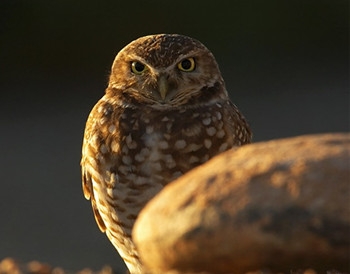
And farming fuelled the growth of another habitat, one that would become an even bigger challenge to North America's wildlife. The modern city was born. The city is an artificial environment, built around the needs of millions of people, and yet it also offers unexpected opportunities for wildlife.
農耕推動了另一個種族棲息地的發展,這個棲息地對于北美野生動物來說是一個更大的挑戰,這就是現代都市。城市是由人類創作的一種環境,這種環境能夠滿足幾百萬人的生活需要,然而它也為野生動物提供了一些意想不到的生存機會。
This burrowing owl lives in one of the biggest high-tech urban sprawls of North America. It maintains a tenacious foothold in Silicon Valley. Burrowing owls originally lived on open prairies, but they've been forced to adapt to city life because the urban environment has grown around them. They survive by occupying any tiny sliver of grassland that remains. Like many city animals, they take advantage of the darkness to protect them and move around mostly at night. These adaptable birds traditionally nest in the burrows of prairie dogs. But in the city, a piece of old pipe will do. The parents split their duties. The father does much of the hunting. But in this case, it's the mother that actually feeds the chicks. The burrowing owl's ability to hover gives it time to judge an attack before pouncing on its prey.
這只穴鴞生活在北美最大的高科技現代都市之一。在硅谷中有著適合他們的落腳點。穴鴞原本生活在開闊的大草原上,但是由于城市在它們身邊拔地而起,它們不得不適應城市生活。它們依靠城市中僅存的草地生存。和許多城市動物一樣,它們利用黑暗保護自己并大多時候于夜晚行動。這些適應了新環境的鳥兒原本將巢穴駐在草原犬鼠的洞穴中。但是在城市中,一根陳舊的管道就足夠它們棲息。鳥兒父母分工行動。父親主要工作是捕食。但在這種情況,真正喂食小鳥的確是母親。穴鴞盤旋的能力使它可以在撲向獵物前做出準確判斷。
英文文本來自普特英語,譯文屬可可原創,僅供學習交流使用,未經許可不得轉載。











